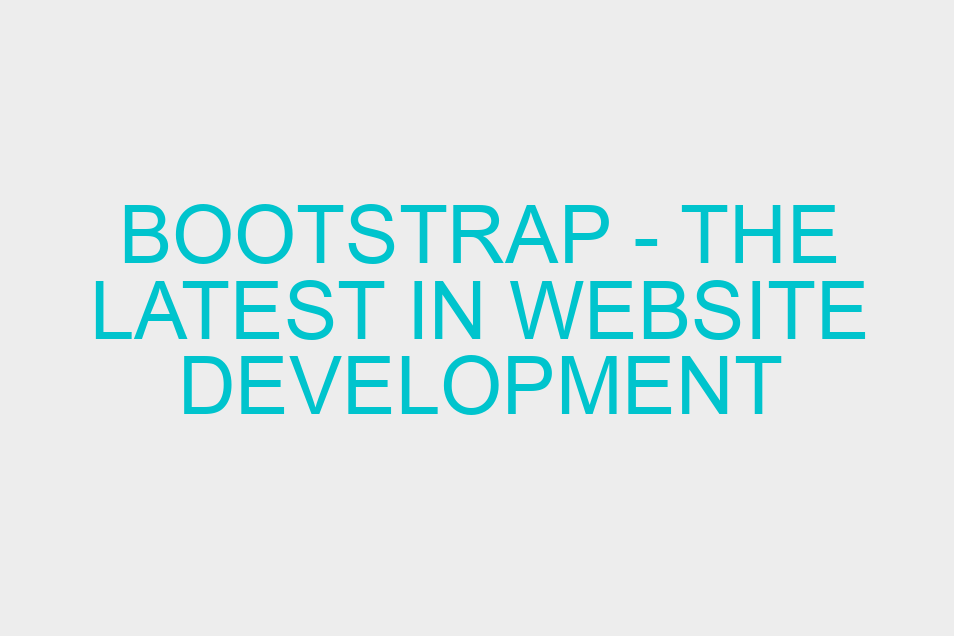Bootstrap – the latest in website development

Here at Ignition Media, we specialise in creating responsive websites and rely on HTML frameworks such as Bootstrap and Foundation for all our website development. Our goal is to create successful online presence for our clients particularly those who are managing small businesses on the Gold Coast and in Brisbane. In this article, we’ll focus on Bootstrap. What is it and why do we think it is one of the best frameworks for your website?
Bootstrap in an open-source JavaScript framework that combines HTML, CSS, and JavaScript code in building user interface components. Programmed to also support both CSS3 and HTML5, it offers free collection of tools for creating websites as well as web applications. It contains CCSS and HTML based design templates for forms, typography, buttons, navigation, and even optional JavaScript extensions.
Getting started with Bootstrap
Since Bootstrap uses CSS properties and HTML elements, you will need to have a code editor and some working knowledge on these programming languages to get started. There are two versions that you can download: Bootstrap source and compiled Bootstrap file. While the latter is a great option for those who have just started in the field of website development, the source download is more appealing to those with higher skill level. This contains original source files for all JavaScript and CSS along with a local copy of the docs.
Ready to Ignite Your Website?
If you are not satisfied with your current website designer or SEO, call me, Nicole Brooke. I’m highly efficient and always available.
For those who want to save bandwidth and to increase the performance of their website, I suggest that you focus on compiled Bootstrap files. With this, you don’t have to worry about separating files for individual functionality. Should you decide to move your website later on, it will be much easier because of lesser HTTP requests and download size since the files are minified and compiled.
Why choose Bootstrap?
- It’s quick and easy – Bootstrap offers ready to use codes so you don’t have to spend working out and writing your code. In addition, several design and styling aspects have already taken care off.
- Make it your own! – Bootstrap allows you to customise your own website. You will be allowed to check the whole framework and decide which one you want to keep and which one you want removed.
- Consistency – Websites made from Bootstraps are uniform across platforms.
- Integration – With Bootstrap, integration is simple, fast, and easy.
- Responsiveness – It quickly adapts to the change in platforms efficiently.
How to make a website with Bootstrap
Creating a responsive template using Bootstrap is relatively easy provided you have some working knowledge on basic programming languages. Consider this section as a basic tutorial. Here, I will assist you in creating a directory structure which is a pre-requisite in creating your website using Bootstrap. Here are the steps:
<code>
<!DOCTYPE html>
<html lang=”en”>
<head>
<meta charset=”utf-8″>
<meta http-equiv=”X-UA-Compatible” content=”IE=edge”>
<meta name=”viewport” content=”width=device-width, initial-scale=1″>
<title>Bootstrap 101 Template</title>
<!– Bootstrap –>
<link href=”css/bootstrap.min.css” rel=”stylesheet”>
<!– HTML5 Shim and Respond.js IE8 support of HTML5 elements and media queries –>
<!– WARNING: Respond.js doesn’t work if you view the page via file:// –>
<!–[if lt IE 9]>
<script src=”https://oss.maxcdn.com/html5shiv/3.7.2/html5shiv.min.js”></script>
<script src=”https://oss.maxcdn.com/respond/1.4.2/respond.min.js”></script>
<![endif]–>
</head>
<body>
<h1>Hello, world!</h1>
<!– jQuery (necessary for Bootstrap’s JavaScript plugins) –>
<script src=”https://ajax.googleapis.com/ajax/libs/jquery/1.11.1/jquery.min.js”></script>
<!– Include all compiled plugins (below), or include individual files as needed –>
<script src=”js/bootstrap.min.js”></script>
</body>
</html>
</code>
- First step is to download Bootstrap and the jQuery JavaScript library.
- Then, create a folder for the files that you have downloaded. Keep in mind that it should be accessed easily so you won’t have to go back and forth later on, wasting time.
- Create “includes” sub folder and two other sub folder that you can name jquery and bootstrap.
- Extract the bootstrap folder’s content and place the latest jQuery library JavaScript file with the jQuery folder.
- Create a blank CSS file within the “includes” folder.
- Lastly, create a blank HTML file called “index.html.”
Creating a responsive HTML document
Setting up the HTML document that features the appropriate Meta tags and required files included is necessary in the development of your responsive bootstrap template. Using HTML code found below, you will be able to create a HTML blank web page with the needed bootstrap JavaScript plug ins and bootstrap CSS files.
Conclusion:
If you like the idea of having your own website built with Bootstrap’s HTML framework but don’t have the time nor the knowledge to do so, Ignition Media can be of great assistance. Here, we specialise in creating responsive websites and rely on frameworks such as Bootstrap. If you have questions or if you require obligation-free quotes, feel free to contact us through this form. You can also talk directly to me, Nicole Brooke, the owner of Ignition Media, by dialing 07 5568 7515 and I’ll be happy to discuss your needs.
Related Topics
